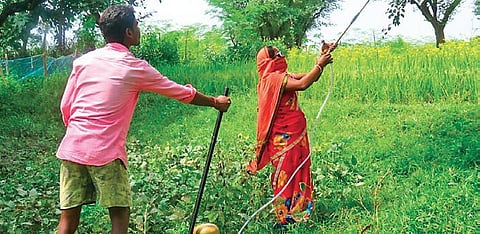

JHARKHAND: For generations, Amrensia Barla in Simdega district of Jharkhand earned from lac cultivation (lac is the resinous secretion of a number of species of lac insects. Cultivation begins when a farmer ties a stick containing eggs ready to hatch to the tree to be infested).
Low productivity and dwindling income forced them to look for other professions. A tradition was on the verge of extinction. Lac resin is extensively used for preparing a range of products, from cosmetics to ammunition. It is cultivated on a variety of trees, mostly fruit-bearing and shady trees like berry, kusum, palash and sal.
In 2016, Amrensia joined a self-help group (SHG) of Jharkhand State Livelihood Promotion Society (JSLPS) and was trained scientifically for lac production under the Mahila Kisan Sashaktiikaran Pariyojana (MKSP). She is now earning three times more than what she earned through traditional methods.
There are more than 73,000 women who earn between Rs 25,000 and Rs 50,000 extra money every year from lac cultivation. “After adopting scientific ways of lac cultivation, the production has increased drastically and we are also getting good returns,” says Amrensia. She hardly earned Rs 10,000 in a season, but now her income is Rs 25,000-30,000 a season, twice a year, she says.
Another woman farmer from Latehar, Ashrita Guria, earned Rs 1.43 lakh last year by adopting modern techniques of lac cultivation. “We were not getting good returns from our produce since we were forced to sell it at throwaway prices. Today, we collect our produce at ‘Gramin Kisan Seva Kendra’ and sell it in bulk to get better returns,” says Arshita Guria. “We are trained for lac cultivation, which includes using the prescribed proportion of pesticides and insecticides. We are also given 5 kg of lac seeds to start our work,” says Ranjeeta Devi of Rumkut village under Goilkera block in West Singhbhum.
“The rural development department is working on Non Timber Forest Products-based livelihood opportunities, under which, women living in villages surrounded by forests are being given training in scientific lac cultivation to improve their income. The traditional practice is being revived through scientific methods,” says Rural Development Secretary Aradhna Patnaik.
She said SHG women are given 25-day training in scientific cultivation by JSLPS by trained Ajivika Vanopaj Mitra. There are 460 collection centres and 25 rural service centres across the state for procuring the produce.